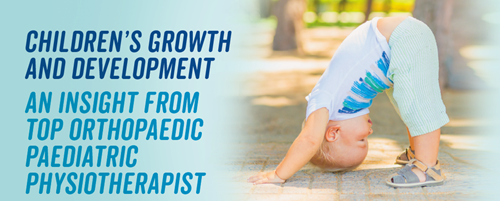Children's Growth and Development

Guest Post by Lyndsey Reynolds
As parents, we often wonder whether our children are developing normally and with so much information readily available, it is difficult to know the most trustworthy source.
In Paediatric Orthopaedics, we see a wide variation of what is and isn’t considered normal, and I’ve given you a taster of some of things we see below.
CHANGE – Children’s bodies are constantly changing – in seemingly no time, your new baby becomes a bustling toddler, jumping in puddles! Positional talipes in a newborn (a flexible deformity of the feet from being confined inside the womb), is a great example of a condition which just needs time for change - over a period of a few weeks, it simply resolves on its own without any need for treatment. In addition to observing these physical transformations firsthand, you can explore online resources like this site to witness how children's bodies change internally, providing a fascinating insight into their growth and development.
HYPERMOBILITY – Refers to how flexible joints are - it is normal for children under 5 to be bendy or flexible (compare any parent and young child attempting to reach their toes to their mouth!). Most children have flat feet up until around age 6, because of their natural joint laxity and underdeveloped muscles. Being flexible has its benefits, particularly in activities such as gymnastics, but it is also important to allow children to build muscle strength through activities such as swimming, climbing (e.g. steps), cycling in the older child and walking.
INJURY – As parents we spend a lot of time mitigating risk, but occasionally accidents happen, particularly with young children who are exploring the world! It can, however, become worrying when your child hurts themselves, particularly if it happens on a regular basis. Frequent falling is a common complaint in orthopaedic clinic and can be caused by poor balance or weak muscles. Falling is, however, normal for toddlers whilst they quite literally “find their feet” with walking, but this would usually improve by around age 5.
LEGS – the appearance of children’s legs can occasionally cause angst in parents of young children. Legs can appear bowed or knock-kneed, feet turned in or perhaps one leg longer than the other. All these appearances can be considered normal at different ages and stages of development. Children’s walking (gait) can sometimes look awkward or clumsy too, and we see some children who have a preference to walk on their toes rather than on a flat foot.
DISCOMFORT/PAIN – Children sometimes complain of pain, but it is not always clear why. In the younger child where they don’t have the understanding or communication skills, pain may be expressed as a reluctance to participate in certain activities or walk for any distance (however this could also represent a strong mindset!). “Growing pains” can be quite common, which can be caused by muscle and bone growth imbalances resulting in tight muscles.
If you have any questions or concerns about your child, seek professional advice. Our Physiotherapists are experts in Paediatric orthopaedics (joints and muscles) and offer Toddle About readers a FREE telephone consultation to see if Physiotherapy is the right choice for you and your child. Please quote “Toddle About” when contacting us.
Lyndsey Reynolds is an Extended Scope Physiotherapist in Paediatric Orthopaedics in a local NHS hospital, and is also co-director of Alpha Physiotherapy, who treat children and adults with a variety of conditions. For further information, email info@alpha-physio.co.uk, call 01473 561060 or visit www.alpha-physio.co.uk.